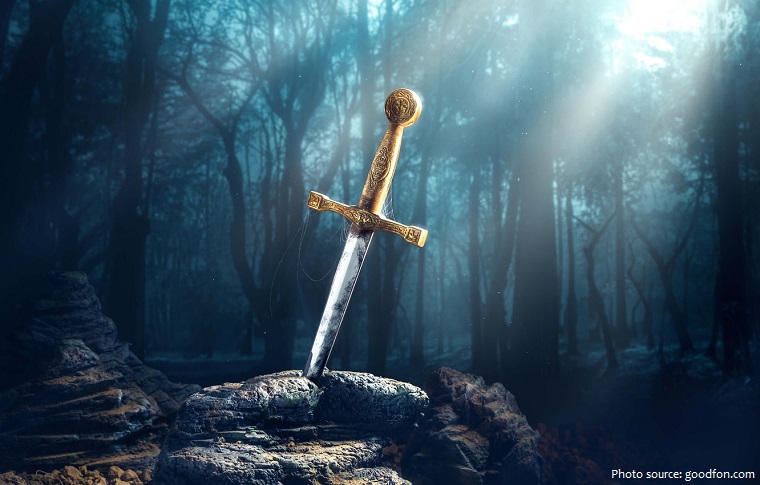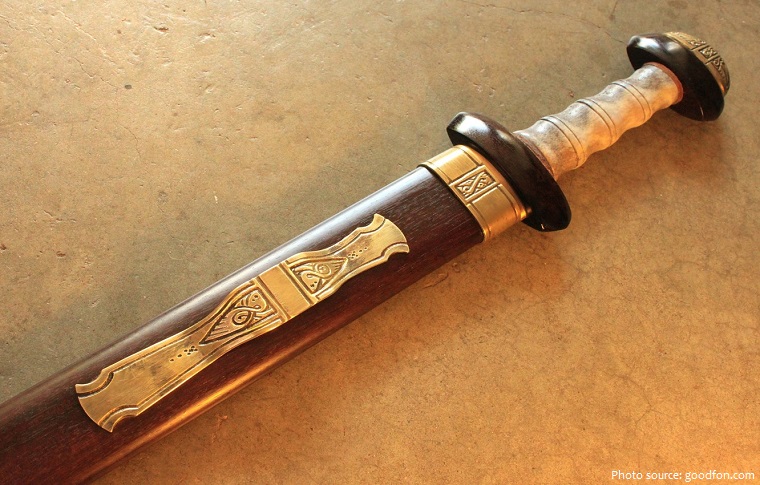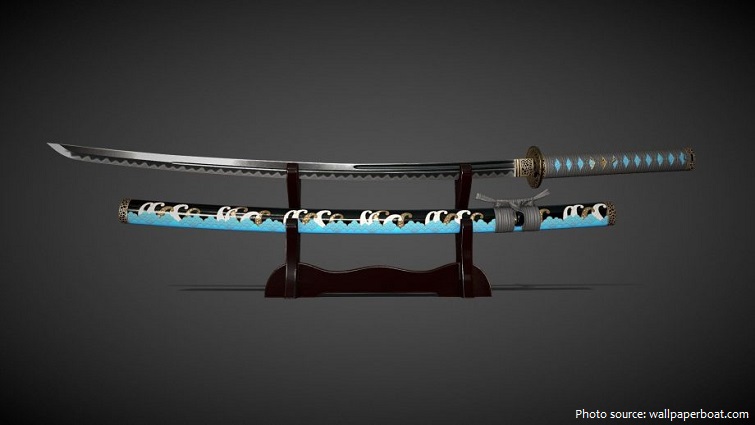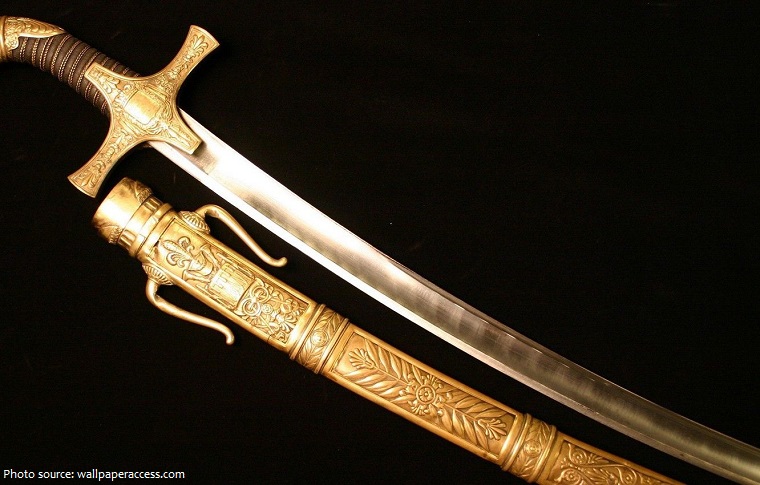
A sword a weapon with a long metal blade and a hilt with a hand guard, used for thrusting or striking and now typically worn as part of ceremonial dress.
The “most romantic of weapons,” the sword has been the symbol of war and the badge of honor and courage among fighting men since the days when bronze and iron were first hammered into blades.
Historically, the sword developed in the Bronze Age (3300 to 1200 BC).
The first weapons that can be described as “swords” date to around 3300 BC. They have been found in Arslantepe, Turkey, are made from arsenical bronze, and are about 60 cm (24 in) long. Some of them are inlaid with silver.

The sword developed from the knife or dagger. A knife is unlike a dagger in that a knife has only one cutting surface, while a dagger has two cutting surfaces. Construction of longer blades became possible during the 3rd millennium BC in the Middle East, first in arsenic copper, then in tin-bronze.
Iron became increasingly common from the 13th century BC. Before that the use of swords was less frequent. The iron was not quench-hardened although often containing sufficient carbon, but work-hardened like bronze by hammering.
Chinese iron swords made their first appearance in the later part of the Western Zhou Dynasty, but iron and steel swords were not widely used until the 3rd century BC Han Dynasty
By Roman times the hilt was distinct from the short, flat blade, and by the Middle Ages the weapon had acquired its main basic forms.

Gladius is a Latin word meaning “sword” (of any type), but in its narrow sense, it refers to the sword of ancient Roman foot soldiers. Early ancient Roman swords were similar to those of the Greeks, called xiphe. From the 3rd century BC, however, the Romans adopted a sword based on the weapons used by the Celtiberians in Hispania late into the Punic Wars, known in Latin as the gladius hispaniensis, or “Hispanic sword”.
The heavy sword of medieval chivalry had a large hilt, often designed to be gripped in both hands, with a large protective guard or pommel at the top. The blade was straight, double-edged, and pointed – it was fabricated by repeated firing and hammering, a process that converted the iron into mild steel by the addition of a small amount of carbon. Blades were also made of laminated strips of iron, which were hammered together. Damascus was a renowned centre of the craft.

In the days of chivalry knighthood was conferred by laying the flat of the sword on the young warrior’s shoulder – in many lands kissing the ruler’s sword was a token of homage – oaths taken by a soldier on his sword were rigidly binding – when a general surrendered his sword, he admitted complete defeat – and to have his sword broken by his superior officer was the worst degradation that could come to the disloyal or cowardly soldier. These and many other sword ceremonies reappear constantly in history, while the mythologies and folklore of many nations contain tales of magic swords, like King Arthur’s Excalibur.
As steel technology improved, single-edged weapons became popular throughout Asia. Derived from the Chinese Jian or dao, the Korean hwandudaedo are known from the early medieval Three Kingdoms. Production of the Japanese tachi, a precursor to the katana, is recorded from c. 900 AD.
A katana is a Japanese sword characterized by a curved, single-edged blade with a circular or squared guardand long grip to accommodate two hands.

Japan was famous for the swords it forged in the early 13th century for the class of warrior-nobility known as the Samurai. Western historians have said that Japanese katana were among the finest cutting weapons in world military history.
The heavy two-handed sword of the Middle Ages was abandoned as soon as the invention of firearms destroyed the usefulness of armor. Its place was taken by the saber, the rapier, and the smallsword. With these lighter blades swordsmanship became a fine art. During the 17th and 18th centuries in Europe, it became the custom for all men, even civilians, to carry swords, and quarrels were usually settled on the spot. In the reign of Louis XIII in France dueling became such a rage that fencing masters were in great demand and highly honored. Earlier, duels were fought with sword in one hand and dagger, for parrying, in the other. Later a cloak took the place of the dagger. Finally with the adoption of the slender needle-pointed rapier even this protection was abandoned.

The advantage of a curved blade for cutting was early appreciated in Asia, where it was long used by the Indians, Persians, and others before its introduction to Europe by the Turks. The Turkish scimitar was modified in the West to the cavalry sabre. At the other extreme of Asia, the Japanese developed a long-bladed, slightly curved version with a two-handed grip, with which an elaborate dueling cult, as well as ancestor worship, became associated.
The introduction of repeating firearms virtually ended the value of the sword as a military weapon, though isolated instances of its use continued in 20th-century wars. As it declined in its military usefulness, the sword gained a new role in the duel, especially in Europe, out of which practice emerged the modern sport of fencing.

The 18th Century Boateng Saber is recognized as the most expensive sword in the world. It originally sold for $5.5 million, and then two years later it sold for a whopping $7.7 million in 2008. The sword was made during the Qianlong rule between 1736 to 1795. The s-shaped black design is equipped with a fitted jade handle, and the blade is decorated with inlaid gold, copper, and silver. As you can imagine, a great deal of work goes into the upkeep of such a sword to ensure its longevity. Not only does the rarity of the sword contribute to its value, but the quality and craftsmanship displayed and the precious metals also play a vital role in bolstering the value of this first and most expensive piece.
Napoleon Bonaparte’s blade is the second most expensive sword ever sold. At about 80 cm (32 inches) long, the sword was made in Italy well over 200 years ago. In 1978, the blade was declared a national treasure by France. This requires the sword to spend at least five months in France each year. Held by Napoleon in the year 1800 during his surprise attack on the Austrian army, this incredible sword sold for 6.4 million dollars in 2007.
The oldest manufacturer of swords – the origins of Wilkinson Sword (UK), the oldest English sword-manufacturing company, can be traced back to 1772, when it was founded by Henry Nock. Wilkinson Sword was appointed as Royal Gun Maker to King George III in 1804 and James Wilkinson became Nock’s partner, after marrying his daughter.
The largest sword measures 14.93 m (48 ft 11.79 in) and was achieved by Fujairah Crown Prince Award (UAE) at the Al Saif roundabout and Fujairah Fort, in Fujairah, UAE, on 16 December 2011.